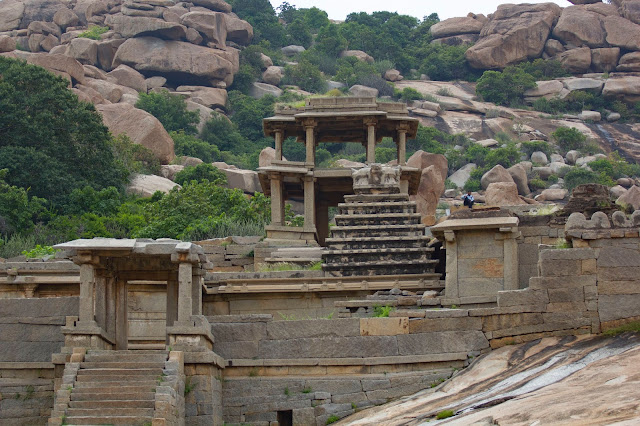Thirumalai Nayakar Mahal is one of the key attractions in Madurai and is a tribute to the glorious rule by its original occupier - King Thirumalai Nayakar.
The Nayaks ruled areas of Madurai, Trichy, Gingee, Mysore, Tanjore for around 200 years from 1540s to 1740s. Thirumalai Nayakar's predecessor had Trichy as its royal residence and there are different stories on why it was moved to Madurai by Thirmalai Nayakar.
a. It is said he had a dream one night and then he consulted with his priests and brahmins who adviced him to move to Madurai
b. The king was affected by a disease which was not getting cured. So Lord Sundareshwara and Meenakshi are said to have come in his dream and advised him to move to Madurai to cure himself.
c. The most logical explanation in my seems to be from an enemy attack point of view, Madurai was better placed as compared to Trichy.
In any case the king decided to move his royal residence to Madurai and decided to construct a palace of such splendor which was unseen and unheard in the area around that time. Of all the Nayakar kings, Thirumalai Nayakar is said to be one of the greatest and ruled from 1623 to 1659. He is credited with constructing several great buildings during his regime included Tellakulam Perumal temple, one of the towers of the Meenakshi amman temple and also excavation of the temple pond of the Meenakshi amman temple. An interesting legend around the king is that, he was an ardent devotee of Srivilliputtur Andal. So he used to have food only after the Pujas at the temple were completed. The temple is at a distance of 75 kms from Madurai. So he constructed smaller temples / mandaps at 5 km intervals who would ring the bell to relay the message to Madurai :)
The palace is a wonderful piece of architecture and has a high European influence obviously since it was conceived by an Italian architect.
The temple had 2 parts - Ranga Vilasam comprising of the main residence and Svarga Vilasam which is the palace courtyard, royal auditorium and dance hall. Only the latter is open to public today. The construction was completed in 1636. The Kings grandson - Sokkanadha Nayakarn dismantled a significant portion of the palace when he wanted to construct his palace in Trichy. Later Lord Napier during 1860s did a lot of restoration work on the palace and restored some portion of the glory.
What strikes anyone on entering the palace is the huge pillars each measuring 89 ft by 19ft and the wonderful symmetry they exhibit.
During various times of the day, the sun provides you with an absolute jugalbandi of lights especially with its striking white and yellow colored pillow colors.
Also of note is the magnificent stucco work, octagonal domes in the royal hall.
To the right of the entry, there is also the dance hall which is now converted into sort of a museum and houses some exquisite paintings of the chola times, sittanavasal paintings etc. The hall by itself is rich in architecture.
A touch of Islamic architecture may be in the below snap ?
Sittanavasal paintings
Chola period paintings from Thanjavur
For the people who are keen on visiting, there is a light show every night at the place which also explains the history of the place. We skipped that due to paucity of time. Also for people keen on the camera, evening time may be the best here.
For the movie buffs who are thinking where have I seen this place before - Santosh Sivan and Maniratnam have immortalised it with their songs in Bombay and Guru.









































































